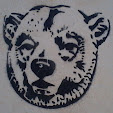Continuing to look at Elephants with a view to scotching a few myths or just generating a better understanding of the practicabilities of using elephants in the field as war-machines.
All these images are taken from Mundy's Pen and Pencil Series - India (or; Journal of a Tour in India by General Godfrey Charles Mundy), published by John Murray, Albermarle Street, 1858 (from the 'Books for Railway Reading series - those were the days; black smuts and a good read...are we there yet Papa?), now available as a Google eBook, but these photographs are taken from a private copy.
How most elephants in most battles in most wars have been attired, heavy blanket protection and a bit of jingly-jangly and colour to add to the overall impression. No heavy wooden tower or throne-like structure, no castellated, crenelated fort with crew of four, no forward firing siege-engine, no overhead protection, just a huge beast with heavy hide running at the enemy with cavalry outriders to keep ham-stringers away.
The purpose of this and the next three images is to show the sort of typical construction of a structure an elephant could be expected to carry for a day - or even a week's expedition - a well-fed elephant mind. It looks as if the front of the howdah, forward of the entrance has been torn away and is falling away over the left shoulder of the elephant.
Here you can see the entrance and the forward screen intact on the elephant being attacked by the enraged - and probably wounded - Tiger, while others have a fully-enclosed howdah, the elephant in the right-hand background for instance, the Europeans are putting their weight on the walls so they must be fairly stable.
Here the construction can be clearly seen to be a light timber (or bamboo?) frame filled in with some sort of fabric, board or matting and with the provision of cartridge-pouches attached (riveted rawhide or sewn leather or canvas?) to the central area of the infill 'screens'.
A grab-rail and parasol are further equipage on both animals, note the means of egress on the left-hand elephant by means of a ladder, the howdahs with 'gates' would be easier to enter from a lower platform. The parasol of the right-hand animal is lying within a cargo compartment a bit like the trunks that would be a feature of early motor-cars.
Here the fabric is quite obvious, note also the carrying of the ladder and the reinforcing cross-spar, which is why the figures in the shooting incident above are able to put their weight against such a light structure. Note also the fourth slimmer (younger?) figure on the lead animal apparently keeping the howdah steady by holding its sides and bracing the rope with his feet.
Also - in all the pictures where it's visible - the Aṅkuśa (Eng.; Ankus, or; Anlius) is a deal longer than most war-game elephant makers provide their mahouts with.
Reading highfalutin language seems to have lead me to write in a more pompous fashion than normal (?!!), despite no actual quoting from the work...so apologies for the hectoring or tutorial tone tonight ("motorcar"!! "equipage"?...Ha-haha!), however as it's one of my life's crusades to see the back of heavy timber forts on toy or model war-elephants, I hope it makes people think...also I can't re-write it as my voice is 'set' now for this piece!
About Me

- Hugh Walter
- No Fixed Abode, Home Counties, United Kingdom
- I’m a 60-year-old Aspergic gardening CAD-Monkey. Sardonic, cynical and with the political leanings of a social reformer, I’m also a toy and model figure collector, particularly interested in the history of plastics and plastic toys. Other interests are history, current affairs, modern art, and architecture, gardening and natural history. I love plain chocolate, fireworks and trees, but I don’t hug them, I do hug kittens. I hate ignorance, when it can be avoided, so I hate the 'educational' establishment and pity the millions they’ve failed with teaching-to-test and rote 'learning' and I hate the short-sighted stupidity of the entire ruling/industrial elite, with their planet destroying fascism and added “buy-one-get-one-free”. Likewise, I also have no time for fools and little time for the false crap we're all supposed to pretend we haven't noticed, or the games we're supposed to play. I will 'bite the hand that feeds', to remind it why it feeds.
Wednesday, March 14, 2012
Subscribe to:
Post Comments (Atom)








No comments:
Post a Comment